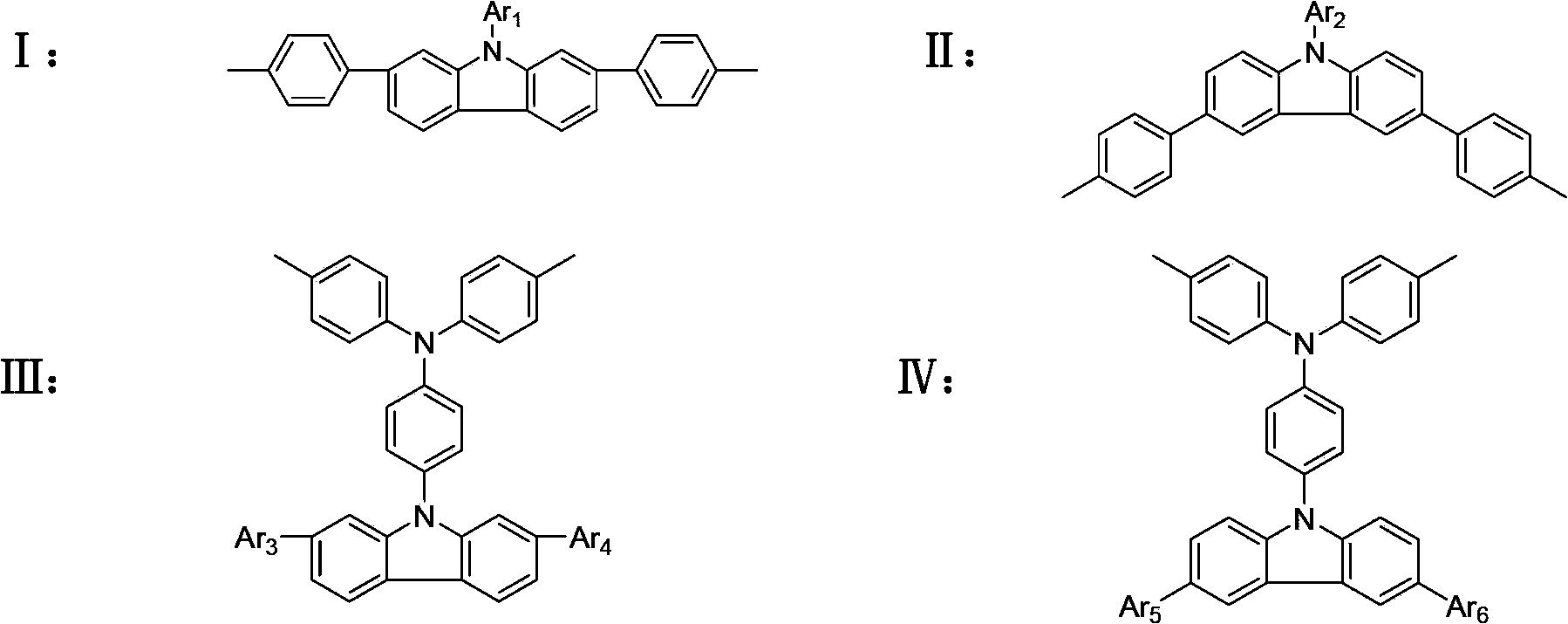Soluble functional polyimide with carbazole structure and preparation method and application thereof
A soluble polyimide and polyimide technology, applied in the field of material science, can solve the problems of single variety and further improvement in performance, and achieve low dielectric constant, excellent thermal stability, and high glass transition temperature. and thermal stability
- Summary
- Abstract
- Description
- Claims
- Application Information
AI Technical Summary
Problems solved by technology
Method used
Image
Examples
Embodiment 1
[0033] At room temperature, 6.2871g (0.01mol) N 1 -(4-(3,6-bis(4-fluorophenyl)-9H-carbazol-9-yl)phenyl)-N 1 -(4-aminophenyl)benzene-1,4-diamine (Kazuo-F) and 67.2ml of N,N-dimethylformamide were added to a 100ml three-neck flask, filled with argon, stirred, and after completely dissolved, added 3.2223g (0.01mol) 3,3',4,4'-Benzophenonetetracarboxylic dianhydride (3,3',4,4'-benzophenonetetracarboxylic dianhydride, BTDA), continue stirring for 12h to obtain a homogeneous viscous polyamic acid solution. Then scrape and coat the polyamic acid solution on the glass plate, then place the glass plate in a vacuum oven and vacuumize it. The heating program is as follows: the room temperature is raised to 100°C and then the temperature is kept constant for 1 hour → 100°C is heated to 200°C and then the temperature is kept constant for the whole process Process 1h→200°C, heat up to 300°C, then keep the temperature constant, the whole process 1h→300°C, heat up to 450°C, keep the temperat...
Embodiment 2
[0036] At room temperature, 6.2871g (0.01mol) N 1 -(4-(3,6-bis(4-fluorophenyl)-9H-carbazol-9-yl)phenyl)-N 1 -(4-aminophenyl)benzene-1,4-diamine (Kazuo-F) and 57.8ml N,N-dimethylformamide were added to a 100ml three-necked flask, filled with argon, stirred, and after completely dissolved, added 2. 9027 g (0.01 mol) of 4,4'-Biphthalic Anhydride (biphenyltetracarboxylic dianhydride, BPDA), continued stirring for 12 hours to obtain a homogeneous viscous polyamic acid solution. Then scrape and coat the polyamic acid solution on the glass plate, then place the glass plate in a vacuum oven, vacuumize, and the heating program is as follows: the temperature is raised from room temperature to 100°C, and then the whole process of constant temperature is 1h → 100°C is heated to 200°C, and then the whole process is constant Process 1h→200°C, heat up to 300°C, then keep the temperature constant, the whole process 1h→300°C, heat up to 450°C, keep the temperature for 1.5h, after cooling, the...
Embodiment 3
[0039] Prepare polyamic acid solution in the same way as in Example 2, and then prepare polyimide by chemical imidization. The steps are as follows: add 5 mL of acetic anhydride to the obtained polyamic acid solution, continue stirring, and then slowly add 2.5 mL of three Ethylamine, and heated to 70°C, continued to stir for 6 hours, then scraped the solution onto a clean glass plate, then placed the glass plate in a vacuum oven, evacuated, and dried at 100°C for 12 hours, and the polyimide film could be taken out after cooling. The infrared spectrogram of this polyimide film is identical with embodiment 2.
PUM
| Property | Measurement | Unit |
|---|---|---|
| temperature | aaaaa | aaaaa |
| temperature | aaaaa | aaaaa |
| temperature | aaaaa | aaaaa |
Abstract
Description
Claims
Application Information
 Login to View More
Login to View More - R&D
- Intellectual Property
- Life Sciences
- Materials
- Tech Scout
- Unparalleled Data Quality
- Higher Quality Content
- 60% Fewer Hallucinations
Browse by: Latest US Patents, China's latest patents, Technical Efficacy Thesaurus, Application Domain, Technology Topic, Popular Technical Reports.
© 2025 PatSnap. All rights reserved.Legal|Privacy policy|Modern Slavery Act Transparency Statement|Sitemap|About US| Contact US: help@patsnap.com



